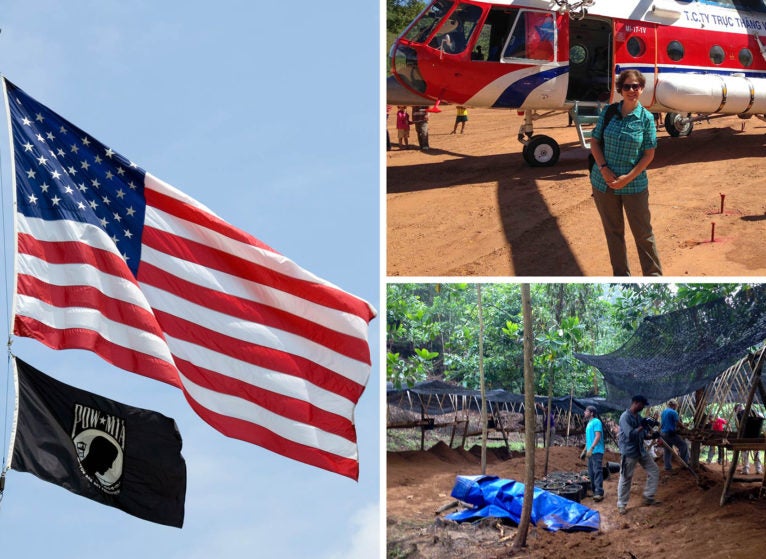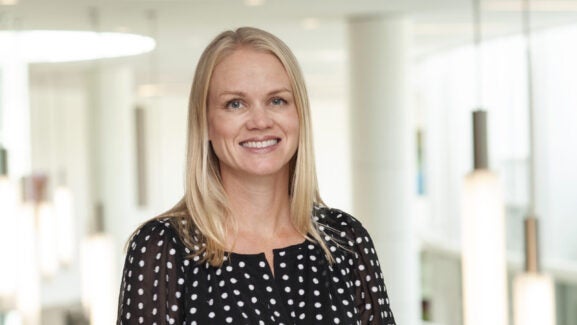

More than 80,000 military service members remain missing, most from World War II. Terri Yost, a 20-year Army veteran who is now an assistant professor of nursing, joined an effort to find and identify the remains of missing military personnel. (Contributed photos)
Nursing Professor Remembers the Missing
Terri Yost, a University of Virginia assistant professor of nursing and a retired Army officer with 20 years of service, once joined an effort to find and return the remains of missing service members lost on foreign battlefields.
The work is often tedious – sifting dirt for bone fragments – and takes place in some of the world’s most remote and inhospitable places. But, she said, it is rewarding to play a small part in an effort to provide families closure.
Ahead of Memorial Day, UVA Today asked Yost about the mission she joined to help identify the missing.
Q. What made you interested in military service?
A. Military careers are often a family affair. My grandfather and several great uncles fought in WWII. My father served in Korea and I have an uncle who was a Navy Seabee in Vietnam. Even my older sister was commissioned as an Army officer after completing her college degree.
When I first began working as a nurse in 1993, almost all of the male patients that I cared for were veterans of WWII. To engage them in something that didn’t involve bloodwork, X-rays, or hospital gowns, I would ask them to tell me stories about their military life and experience. They could talk about their war experiences with such detail, you would have thought that it had just happened last week. I absolutely loved caring for my “old soldiers.”
A few years later, I visited my sister, who was at that time stationed in Berlin. Because it was only a few years after the fall of the Berlin Wall and Germany’s reunification, we could freely explore what was, at that time, old East Berlin. Having grown up during the Cold War, it seemed surreal for me to be doing so, but I was seeing history being made firsthand. I found myself a bit jealous of her lifestyle and adventures.
One morning, just a few weeks after that trip, I was watching TV and an Army commercial came on. I immediately got in my car, drove to a recruiting station and began the process to become an Army nurse. That is exactly how it happened.

Q. What is the Defense POW/MIA Accounting Agency?
A. The DPAA is an agency within the Department of Defense whose mission is to recover and account for all military service members who are, as of yet, still classified as being prisoners of war (POW) or missing in action (MIA).
At any given time, small teams including archaeologists, life scientists, translators, and specialists with expertise in mortuary affairs, ordinance, medical support, photography and mountaineering search for our fallen in places like Laos, Cambodia, Papua New Guinea, the Philippines, Germany, Italy, and even North Korea.
The DPAA website provides extensive details on its missions and tells the stories of these missing personnel. They also provide an ongoing list of the names of those recently accounted for, which includes their military unit, conflict of deployment and dates/countries of recovery.
Viewing and reflecting on the names on this list is to me, a meaningful way to observe Memorial Day, the day dedicated to remembering and honoring those who have lost their lives in service to our country.
Q. How many service members remain missing?
A. Currently, there are still more than 73,000 service members still unaccounted for from World War II, over 7,500 from the Korean War, over 1,500 from Vietnam, and six from the conflicts in Iraq and the Persian Gulf. An additional 105 personnel are unaccounted for while serving in the Cold War.
Q. What personally did you take away from your time with this mission?
A. Deploying to Vietnam provided me with an incredible opportunity to see firsthand what reconciliation can look like after war. We worked side-by-side with Vietnamese military officers and local citizens who quickly became our friends. It was very healing for me and allowed me to close out my military career with a real sense of optimism.
Q. What has your military service, and your work to find the remains of missing service members, instilled in you that you pass on to your students?
A. One very critical tenet of the military is that the mission is more important than the individual. I have always found in my professional life, both in and out of the Army, that a “mission-focused” approach provides a real sense of purpose and clear direction, particularly in times of high stress. It’s a mindset that instinctively inspires teamwork and camaraderie. In Vietnam, the mission was not only clear, but it was also pure and honorable.
Working in health care is also an important form of service to one’s community. Improving patient outcomes, preventing errors and maintaining workplace civility in a high-stress environment requires a team approach. Much like the unique expertise of the many individuals that comprised a DPAA team, a health care team requires a multidisciplinary approach comprised of individuals with unique and complementary expertise.
As part of my teaching philosophy, I like to emphasize the concept of nursing as a form of service to one’s community and stress the importance of being supportive members of a team working side-by-side on behalf of our patients, our mission.
Latest News



